Strategic Report: Xerox's Strategic Management and Restructure Plan
VerifiedAdded on 2021/02/20
|23
|7701
|397
Report
AI Summary
This report provides a comprehensive analysis of Xerox's strategic management, examining the relationship between strategy, stakeholder expectations, and organizational performance. It explores the selection of a strategic management theory, identifies and evaluates the impact of external factors in an international context, and formulates new strategies to overcome challenges and meet organizational goals. The report also discusses the role of innovation and change in strategic management, develops an implementation plan, and analyzes Xerox's current organizational structure, including a critical evaluation of a proposed restructure plan. The report concludes with recommendations and references, offering a detailed overview of Xerox's strategic approach to business operations.
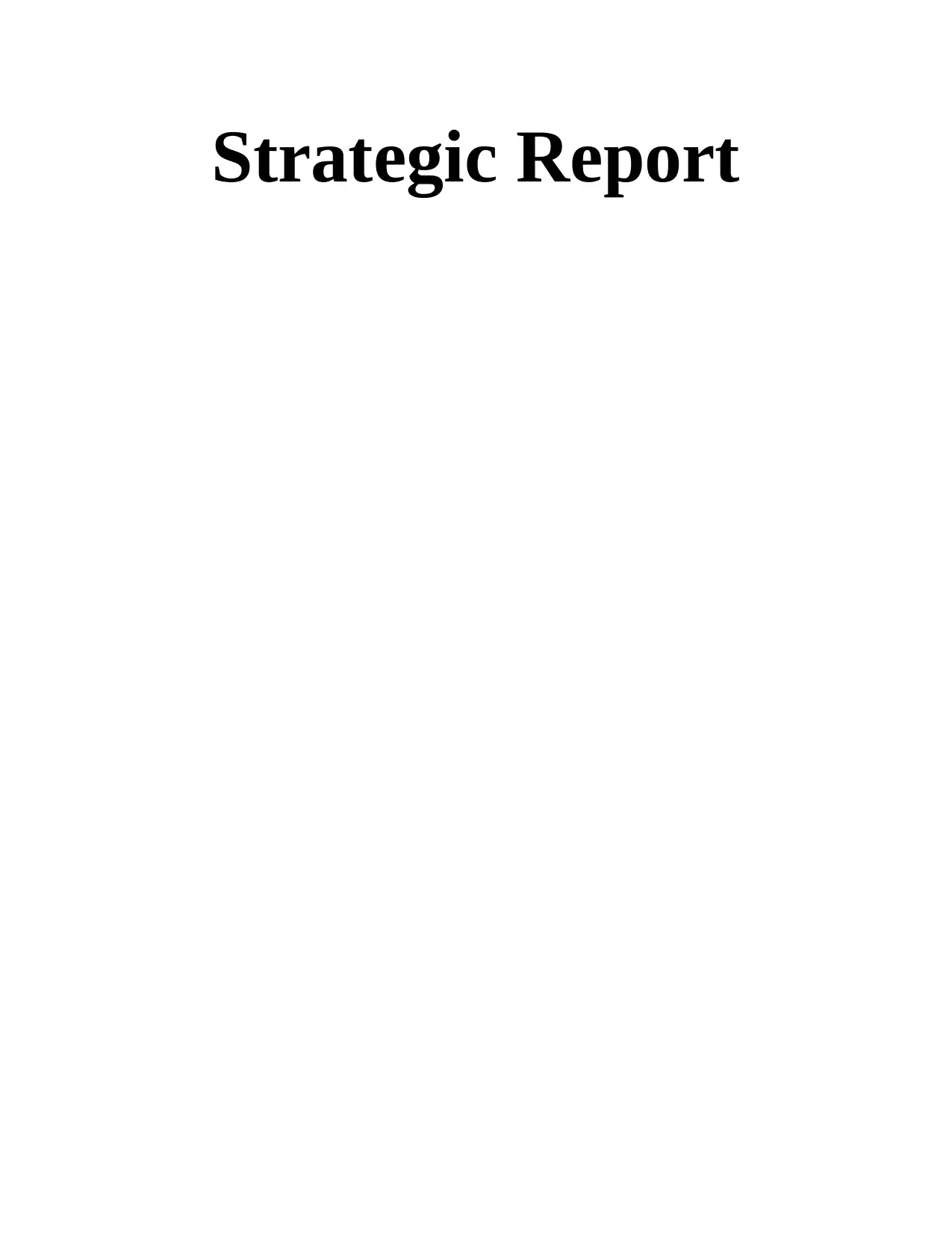
Strategic Report
Paraphrase This Document
Need a fresh take? Get an instant paraphrase of this document with our AI Paraphraser
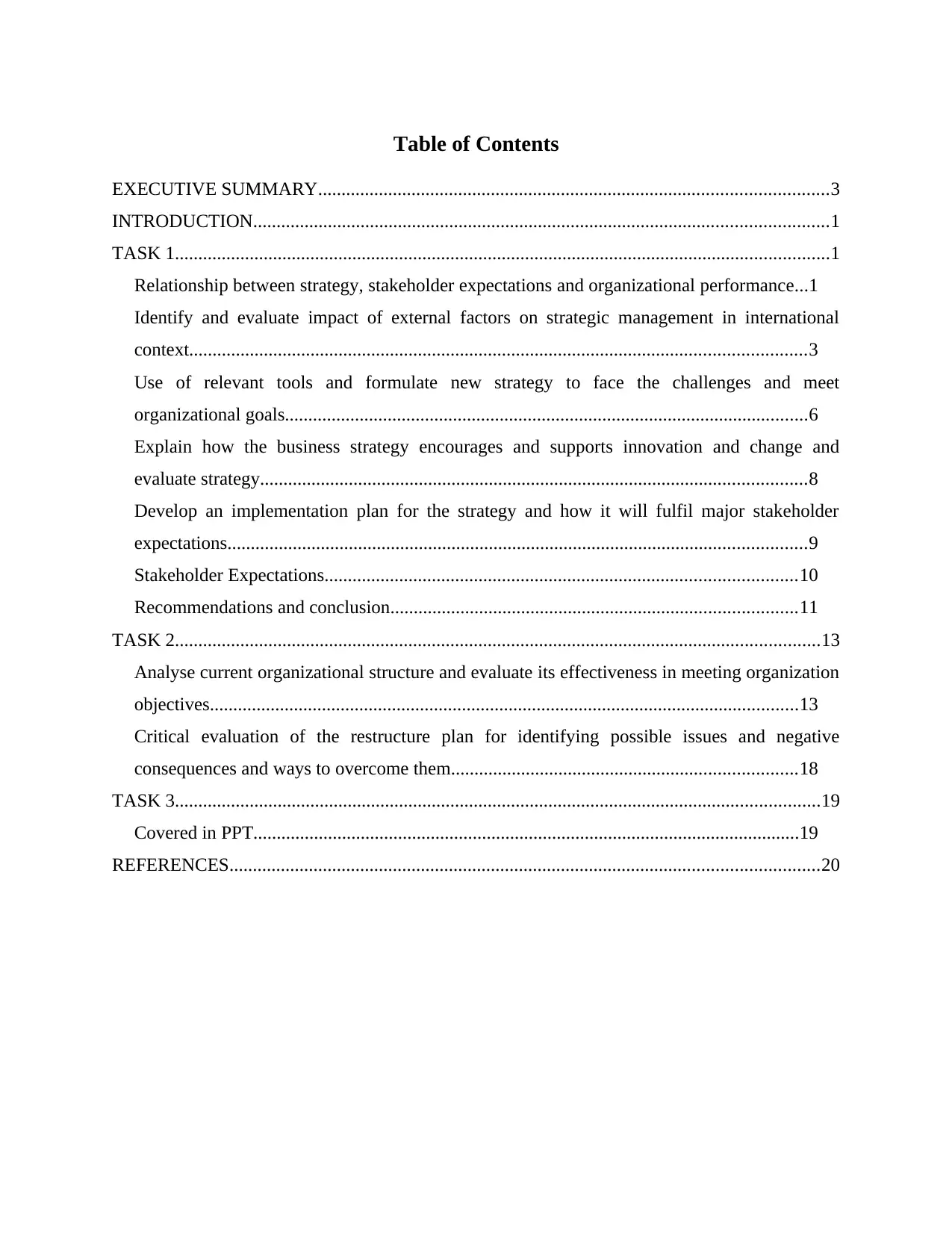
Table of Contents
EXECUTIVE SUMMARY.............................................................................................................3
INTRODUCTION...........................................................................................................................1
TASK 1............................................................................................................................................1
Relationship between strategy, stakeholder expectations and organizational performance...1
Identify and evaluate impact of external factors on strategic management in international
context....................................................................................................................................3
Use of relevant tools and formulate new strategy to face the challenges and meet
organizational goals................................................................................................................6
Explain how the business strategy encourages and supports innovation and change and
evaluate strategy.....................................................................................................................8
Develop an implementation plan for the strategy and how it will fulfil major stakeholder
expectations............................................................................................................................9
Stakeholder Expectations.....................................................................................................10
Recommendations and conclusion.......................................................................................11
TASK 2..........................................................................................................................................13
Analyse current organizational structure and evaluate its effectiveness in meeting organization
objectives..............................................................................................................................13
Critical evaluation of the restructure plan for identifying possible issues and negative
consequences and ways to overcome them..........................................................................18
TASK 3..........................................................................................................................................19
Covered in PPT.....................................................................................................................19
REFERENCES..............................................................................................................................20
EXECUTIVE SUMMARY.............................................................................................................3
INTRODUCTION...........................................................................................................................1
TASK 1............................................................................................................................................1
Relationship between strategy, stakeholder expectations and organizational performance...1
Identify and evaluate impact of external factors on strategic management in international
context....................................................................................................................................3
Use of relevant tools and formulate new strategy to face the challenges and meet
organizational goals................................................................................................................6
Explain how the business strategy encourages and supports innovation and change and
evaluate strategy.....................................................................................................................8
Develop an implementation plan for the strategy and how it will fulfil major stakeholder
expectations............................................................................................................................9
Stakeholder Expectations.....................................................................................................10
Recommendations and conclusion.......................................................................................11
TASK 2..........................................................................................................................................13
Analyse current organizational structure and evaluate its effectiveness in meeting organization
objectives..............................................................................................................................13
Critical evaluation of the restructure plan for identifying possible issues and negative
consequences and ways to overcome them..........................................................................18
TASK 3..........................................................................................................................................19
Covered in PPT.....................................................................................................................19
REFERENCES..............................................................................................................................20
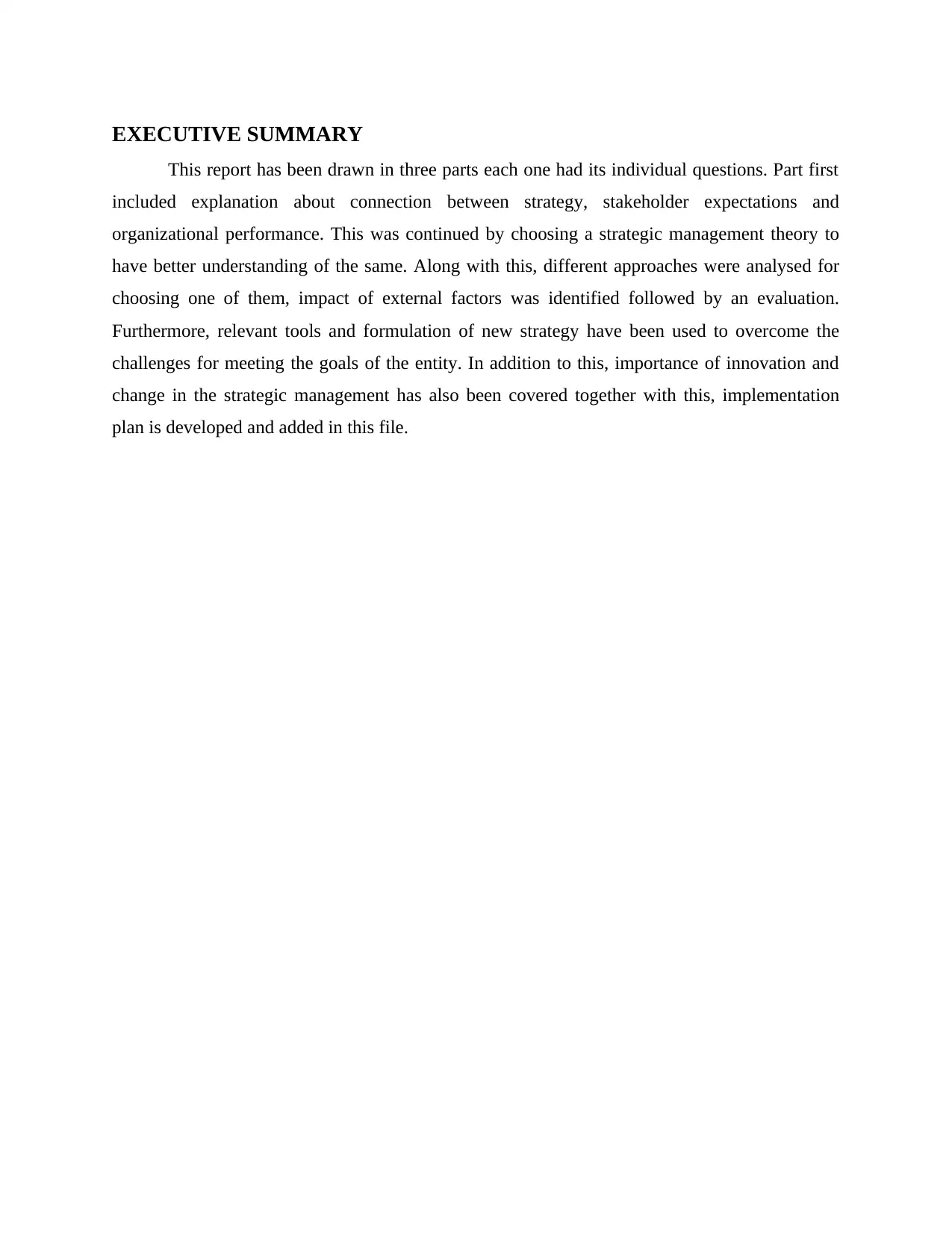
EXECUTIVE SUMMARY
This report has been drawn in three parts each one had its individual questions. Part first
included explanation about connection between strategy, stakeholder expectations and
organizational performance. This was continued by choosing a strategic management theory to
have better understanding of the same. Along with this, different approaches were analysed for
choosing one of them, impact of external factors was identified followed by an evaluation.
Furthermore, relevant tools and formulation of new strategy have been used to overcome the
challenges for meeting the goals of the entity. In addition to this, importance of innovation and
change in the strategic management has also been covered together with this, implementation
plan is developed and added in this file.
This report has been drawn in three parts each one had its individual questions. Part first
included explanation about connection between strategy, stakeholder expectations and
organizational performance. This was continued by choosing a strategic management theory to
have better understanding of the same. Along with this, different approaches were analysed for
choosing one of them, impact of external factors was identified followed by an evaluation.
Furthermore, relevant tools and formulation of new strategy have been used to overcome the
challenges for meeting the goals of the entity. In addition to this, importance of innovation and
change in the strategic management has also been covered together with this, implementation
plan is developed and added in this file.
⊘ This is a preview!⊘
Do you want full access?
Subscribe today to unlock all pages.

Trusted by 1+ million students worldwide
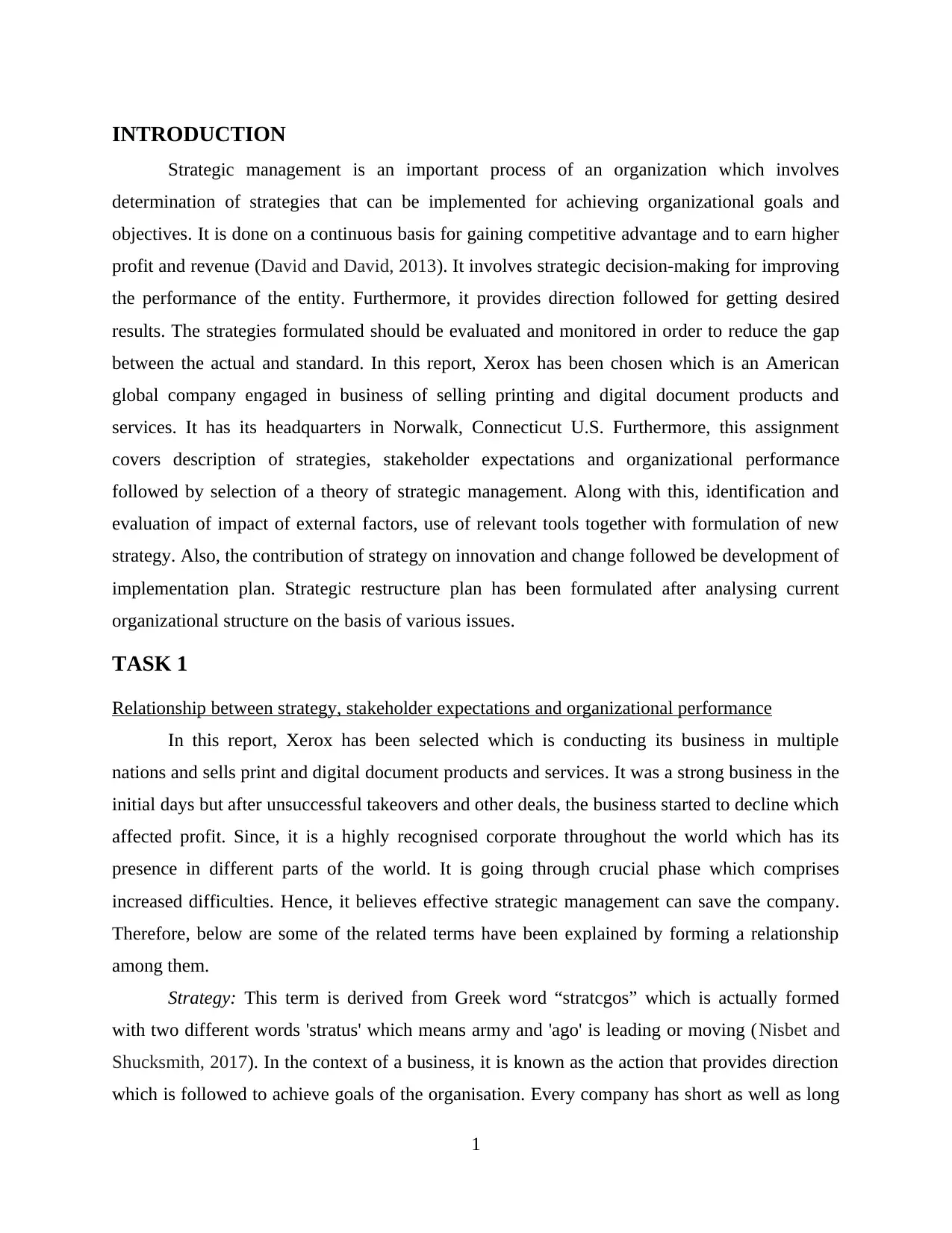
INTRODUCTION
Strategic management is an important process of an organization which involves
determination of strategies that can be implemented for achieving organizational goals and
objectives. It is done on a continuous basis for gaining competitive advantage and to earn higher
profit and revenue (David and David, 2013). It involves strategic decision-making for improving
the performance of the entity. Furthermore, it provides direction followed for getting desired
results. The strategies formulated should be evaluated and monitored in order to reduce the gap
between the actual and standard. In this report, Xerox has been chosen which is an American
global company engaged in business of selling printing and digital document products and
services. It has its headquarters in Norwalk, Connecticut U.S. Furthermore, this assignment
covers description of strategies, stakeholder expectations and organizational performance
followed by selection of a theory of strategic management. Along with this, identification and
evaluation of impact of external factors, use of relevant tools together with formulation of new
strategy. Also, the contribution of strategy on innovation and change followed be development of
implementation plan. Strategic restructure plan has been formulated after analysing current
organizational structure on the basis of various issues.
TASK 1
Relationship between strategy, stakeholder expectations and organizational performance
In this report, Xerox has been selected which is conducting its business in multiple
nations and sells print and digital document products and services. It was a strong business in the
initial days but after unsuccessful takeovers and other deals, the business started to decline which
affected profit. Since, it is a highly recognised corporate throughout the world which has its
presence in different parts of the world. It is going through crucial phase which comprises
increased difficulties. Hence, it believes effective strategic management can save the company.
Therefore, below are some of the related terms have been explained by forming a relationship
among them.
Strategy: This term is derived from Greek word “stratcgos” which is actually formed
with two different words 'stratus' which means army and 'ago' is leading or moving (Nisbet and
Shucksmith, 2017). In the context of a business, it is known as the action that provides direction
which is followed to achieve goals of the organisation. Every company has short as well as long
1
Strategic management is an important process of an organization which involves
determination of strategies that can be implemented for achieving organizational goals and
objectives. It is done on a continuous basis for gaining competitive advantage and to earn higher
profit and revenue (David and David, 2013). It involves strategic decision-making for improving
the performance of the entity. Furthermore, it provides direction followed for getting desired
results. The strategies formulated should be evaluated and monitored in order to reduce the gap
between the actual and standard. In this report, Xerox has been chosen which is an American
global company engaged in business of selling printing and digital document products and
services. It has its headquarters in Norwalk, Connecticut U.S. Furthermore, this assignment
covers description of strategies, stakeholder expectations and organizational performance
followed by selection of a theory of strategic management. Along with this, identification and
evaluation of impact of external factors, use of relevant tools together with formulation of new
strategy. Also, the contribution of strategy on innovation and change followed be development of
implementation plan. Strategic restructure plan has been formulated after analysing current
organizational structure on the basis of various issues.
TASK 1
Relationship between strategy, stakeholder expectations and organizational performance
In this report, Xerox has been selected which is conducting its business in multiple
nations and sells print and digital document products and services. It was a strong business in the
initial days but after unsuccessful takeovers and other deals, the business started to decline which
affected profit. Since, it is a highly recognised corporate throughout the world which has its
presence in different parts of the world. It is going through crucial phase which comprises
increased difficulties. Hence, it believes effective strategic management can save the company.
Therefore, below are some of the related terms have been explained by forming a relationship
among them.
Strategy: This term is derived from Greek word “stratcgos” which is actually formed
with two different words 'stratus' which means army and 'ago' is leading or moving (Nisbet and
Shucksmith, 2017). In the context of a business, it is known as the action that provides direction
which is followed to achieve goals of the organisation. Every company has short as well as long
1
Paraphrase This Document
Need a fresh take? Get an instant paraphrase of this document with our AI Paraphraser
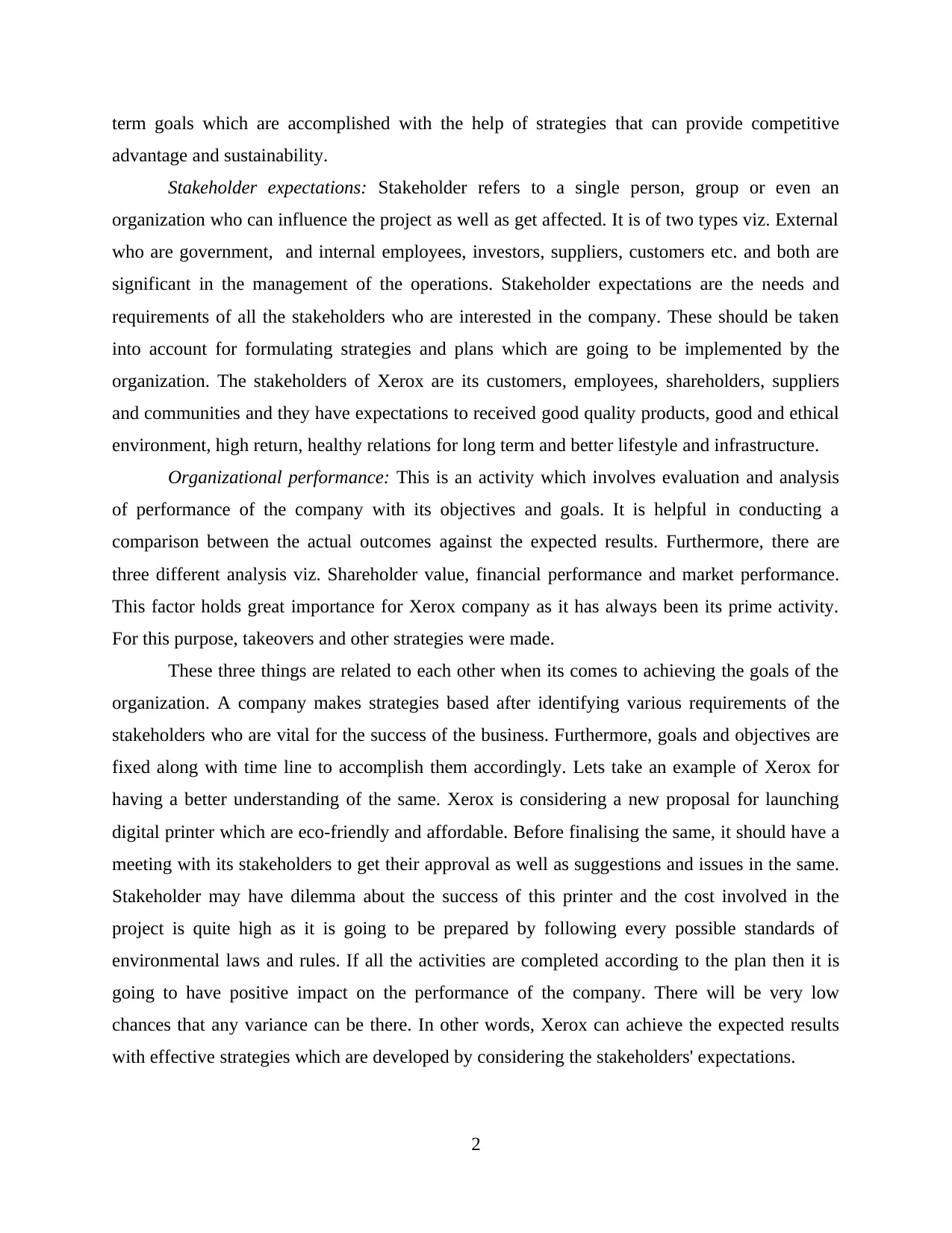
term goals which are accomplished with the help of strategies that can provide competitive
advantage and sustainability.
Stakeholder expectations: Stakeholder refers to a single person, group or even an
organization who can influence the project as well as get affected. It is of two types viz. External
who are government, and internal employees, investors, suppliers, customers etc. and both are
significant in the management of the operations. Stakeholder expectations are the needs and
requirements of all the stakeholders who are interested in the company. These should be taken
into account for formulating strategies and plans which are going to be implemented by the
organization. The stakeholders of Xerox are its customers, employees, shareholders, suppliers
and communities and they have expectations to received good quality products, good and ethical
environment, high return, healthy relations for long term and better lifestyle and infrastructure.
Organizational performance: This is an activity which involves evaluation and analysis
of performance of the company with its objectives and goals. It is helpful in conducting a
comparison between the actual outcomes against the expected results. Furthermore, there are
three different analysis viz. Shareholder value, financial performance and market performance.
This factor holds great importance for Xerox company as it has always been its prime activity.
For this purpose, takeovers and other strategies were made.
These three things are related to each other when its comes to achieving the goals of the
organization. A company makes strategies based after identifying various requirements of the
stakeholders who are vital for the success of the business. Furthermore, goals and objectives are
fixed along with time line to accomplish them accordingly. Lets take an example of Xerox for
having a better understanding of the same. Xerox is considering a new proposal for launching
digital printer which are eco-friendly and affordable. Before finalising the same, it should have a
meeting with its stakeholders to get their approval as well as suggestions and issues in the same.
Stakeholder may have dilemma about the success of this printer and the cost involved in the
project is quite high as it is going to be prepared by following every possible standards of
environmental laws and rules. If all the activities are completed according to the plan then it is
going to have positive impact on the performance of the company. There will be very low
chances that any variance can be there. In other words, Xerox can achieve the expected results
with effective strategies which are developed by considering the stakeholders' expectations.
2
advantage and sustainability.
Stakeholder expectations: Stakeholder refers to a single person, group or even an
organization who can influence the project as well as get affected. It is of two types viz. External
who are government, and internal employees, investors, suppliers, customers etc. and both are
significant in the management of the operations. Stakeholder expectations are the needs and
requirements of all the stakeholders who are interested in the company. These should be taken
into account for formulating strategies and plans which are going to be implemented by the
organization. The stakeholders of Xerox are its customers, employees, shareholders, suppliers
and communities and they have expectations to received good quality products, good and ethical
environment, high return, healthy relations for long term and better lifestyle and infrastructure.
Organizational performance: This is an activity which involves evaluation and analysis
of performance of the company with its objectives and goals. It is helpful in conducting a
comparison between the actual outcomes against the expected results. Furthermore, there are
three different analysis viz. Shareholder value, financial performance and market performance.
This factor holds great importance for Xerox company as it has always been its prime activity.
For this purpose, takeovers and other strategies were made.
These three things are related to each other when its comes to achieving the goals of the
organization. A company makes strategies based after identifying various requirements of the
stakeholders who are vital for the success of the business. Furthermore, goals and objectives are
fixed along with time line to accomplish them accordingly. Lets take an example of Xerox for
having a better understanding of the same. Xerox is considering a new proposal for launching
digital printer which are eco-friendly and affordable. Before finalising the same, it should have a
meeting with its stakeholders to get their approval as well as suggestions and issues in the same.
Stakeholder may have dilemma about the success of this printer and the cost involved in the
project is quite high as it is going to be prepared by following every possible standards of
environmental laws and rules. If all the activities are completed according to the plan then it is
going to have positive impact on the performance of the company. There will be very low
chances that any variance can be there. In other words, Xerox can achieve the expected results
with effective strategies which are developed by considering the stakeholders' expectations.
2
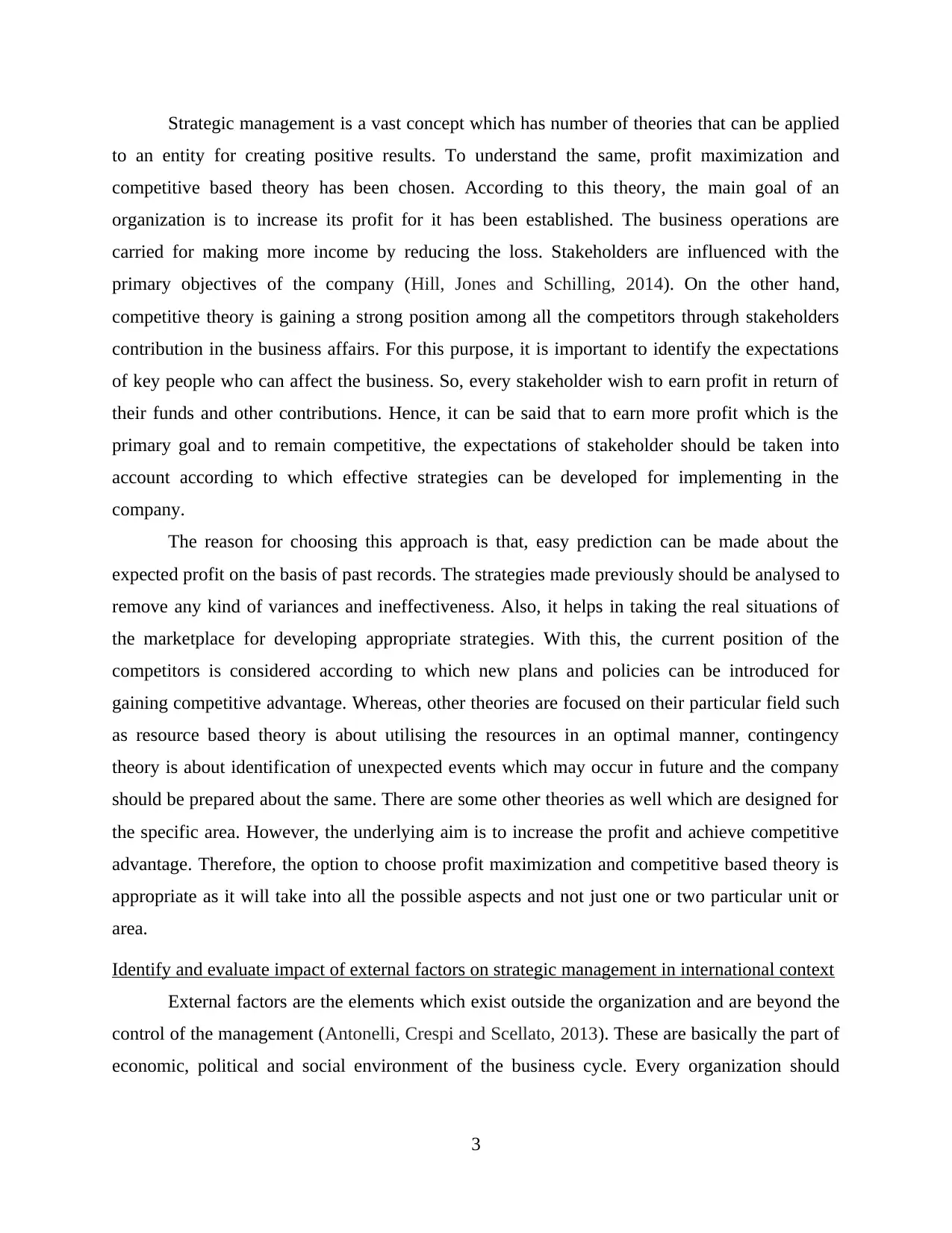
Strategic management is a vast concept which has number of theories that can be applied
to an entity for creating positive results. To understand the same, profit maximization and
competitive based theory has been chosen. According to this theory, the main goal of an
organization is to increase its profit for it has been established. The business operations are
carried for making more income by reducing the loss. Stakeholders are influenced with the
primary objectives of the company (Hill, Jones and Schilling, 2014). On the other hand,
competitive theory is gaining a strong position among all the competitors through stakeholders
contribution in the business affairs. For this purpose, it is important to identify the expectations
of key people who can affect the business. So, every stakeholder wish to earn profit in return of
their funds and other contributions. Hence, it can be said that to earn more profit which is the
primary goal and to remain competitive, the expectations of stakeholder should be taken into
account according to which effective strategies can be developed for implementing in the
company.
The reason for choosing this approach is that, easy prediction can be made about the
expected profit on the basis of past records. The strategies made previously should be analysed to
remove any kind of variances and ineffectiveness. Also, it helps in taking the real situations of
the marketplace for developing appropriate strategies. With this, the current position of the
competitors is considered according to which new plans and policies can be introduced for
gaining competitive advantage. Whereas, other theories are focused on their particular field such
as resource based theory is about utilising the resources in an optimal manner, contingency
theory is about identification of unexpected events which may occur in future and the company
should be prepared about the same. There are some other theories as well which are designed for
the specific area. However, the underlying aim is to increase the profit and achieve competitive
advantage. Therefore, the option to choose profit maximization and competitive based theory is
appropriate as it will take into all the possible aspects and not just one or two particular unit or
area.
Identify and evaluate impact of external factors on strategic management in international context
External factors are the elements which exist outside the organization and are beyond the
control of the management (Antonelli, Crespi and Scellato, 2013). These are basically the part of
economic, political and social environment of the business cycle. Every organization should
3
to an entity for creating positive results. To understand the same, profit maximization and
competitive based theory has been chosen. According to this theory, the main goal of an
organization is to increase its profit for it has been established. The business operations are
carried for making more income by reducing the loss. Stakeholders are influenced with the
primary objectives of the company (Hill, Jones and Schilling, 2014). On the other hand,
competitive theory is gaining a strong position among all the competitors through stakeholders
contribution in the business affairs. For this purpose, it is important to identify the expectations
of key people who can affect the business. So, every stakeholder wish to earn profit in return of
their funds and other contributions. Hence, it can be said that to earn more profit which is the
primary goal and to remain competitive, the expectations of stakeholder should be taken into
account according to which effective strategies can be developed for implementing in the
company.
The reason for choosing this approach is that, easy prediction can be made about the
expected profit on the basis of past records. The strategies made previously should be analysed to
remove any kind of variances and ineffectiveness. Also, it helps in taking the real situations of
the marketplace for developing appropriate strategies. With this, the current position of the
competitors is considered according to which new plans and policies can be introduced for
gaining competitive advantage. Whereas, other theories are focused on their particular field such
as resource based theory is about utilising the resources in an optimal manner, contingency
theory is about identification of unexpected events which may occur in future and the company
should be prepared about the same. There are some other theories as well which are designed for
the specific area. However, the underlying aim is to increase the profit and achieve competitive
advantage. Therefore, the option to choose profit maximization and competitive based theory is
appropriate as it will take into all the possible aspects and not just one or two particular unit or
area.
Identify and evaluate impact of external factors on strategic management in international context
External factors are the elements which exist outside the organization and are beyond the
control of the management (Antonelli, Crespi and Scellato, 2013). These are basically the part of
economic, political and social environment of the business cycle. Every organization should
3
⊘ This is a preview!⊘
Do you want full access?
Subscribe today to unlock all pages.

Trusted by 1+ million students worldwide
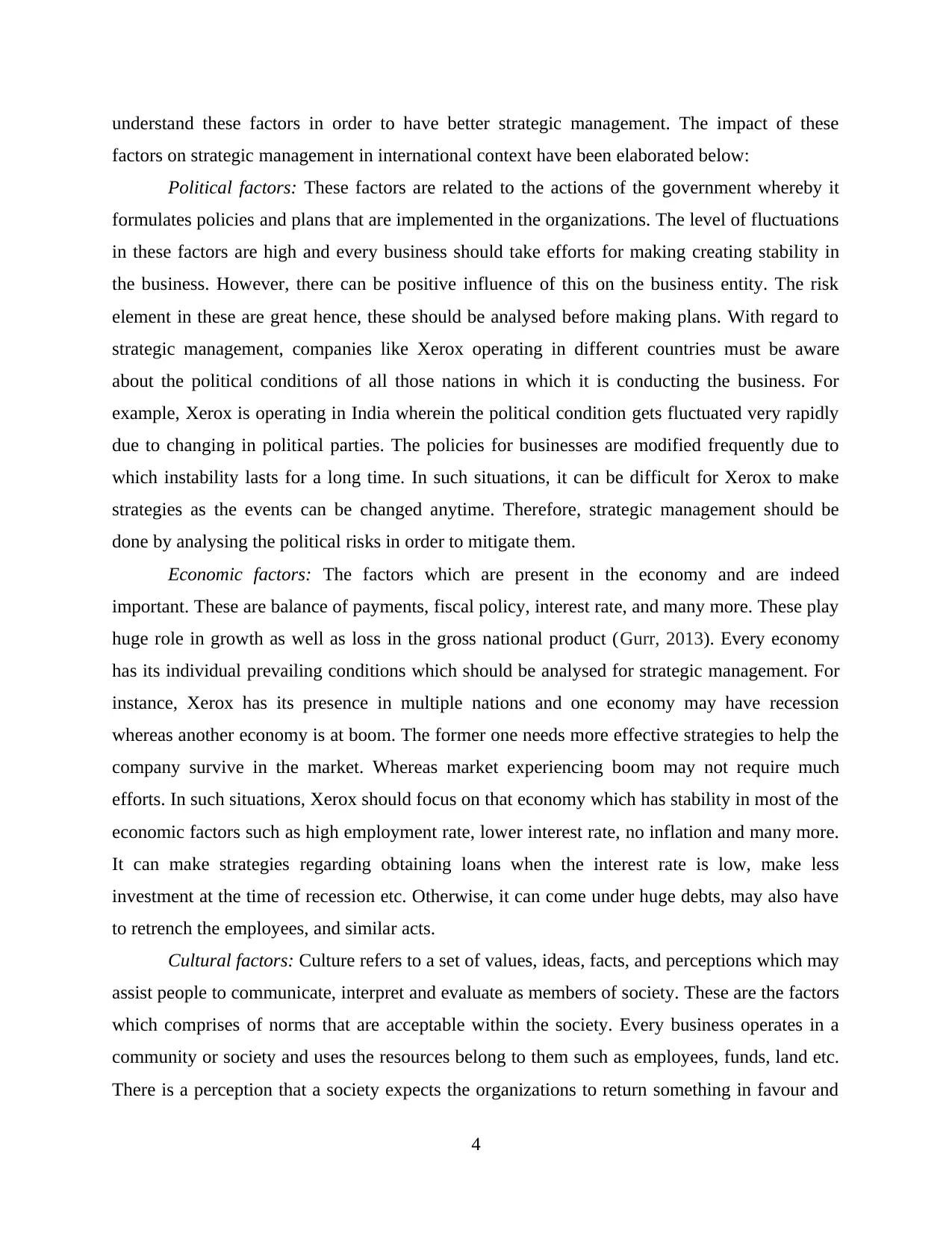
understand these factors in order to have better strategic management. The impact of these
factors on strategic management in international context have been elaborated below:
Political factors: These factors are related to the actions of the government whereby it
formulates policies and plans that are implemented in the organizations. The level of fluctuations
in these factors are high and every business should take efforts for making creating stability in
the business. However, there can be positive influence of this on the business entity. The risk
element in these are great hence, these should be analysed before making plans. With regard to
strategic management, companies like Xerox operating in different countries must be aware
about the political conditions of all those nations in which it is conducting the business. For
example, Xerox is operating in India wherein the political condition gets fluctuated very rapidly
due to changing in political parties. The policies for businesses are modified frequently due to
which instability lasts for a long time. In such situations, it can be difficult for Xerox to make
strategies as the events can be changed anytime. Therefore, strategic management should be
done by analysing the political risks in order to mitigate them.
Economic factors: The factors which are present in the economy and are indeed
important. These are balance of payments, fiscal policy, interest rate, and many more. These play
huge role in growth as well as loss in the gross national product (Gurr, 2013). Every economy
has its individual prevailing conditions which should be analysed for strategic management. For
instance, Xerox has its presence in multiple nations and one economy may have recession
whereas another economy is at boom. The former one needs more effective strategies to help the
company survive in the market. Whereas market experiencing boom may not require much
efforts. In such situations, Xerox should focus on that economy which has stability in most of the
economic factors such as high employment rate, lower interest rate, no inflation and many more.
It can make strategies regarding obtaining loans when the interest rate is low, make less
investment at the time of recession etc. Otherwise, it can come under huge debts, may also have
to retrench the employees, and similar acts.
Cultural factors: Culture refers to a set of values, ideas, facts, and perceptions which may
assist people to communicate, interpret and evaluate as members of society. These are the factors
which comprises of norms that are acceptable within the society. Every business operates in a
community or society and uses the resources belong to them such as employees, funds, land etc.
There is a perception that a society expects the organizations to return something in favour and
4
factors on strategic management in international context have been elaborated below:
Political factors: These factors are related to the actions of the government whereby it
formulates policies and plans that are implemented in the organizations. The level of fluctuations
in these factors are high and every business should take efforts for making creating stability in
the business. However, there can be positive influence of this on the business entity. The risk
element in these are great hence, these should be analysed before making plans. With regard to
strategic management, companies like Xerox operating in different countries must be aware
about the political conditions of all those nations in which it is conducting the business. For
example, Xerox is operating in India wherein the political condition gets fluctuated very rapidly
due to changing in political parties. The policies for businesses are modified frequently due to
which instability lasts for a long time. In such situations, it can be difficult for Xerox to make
strategies as the events can be changed anytime. Therefore, strategic management should be
done by analysing the political risks in order to mitigate them.
Economic factors: The factors which are present in the economy and are indeed
important. These are balance of payments, fiscal policy, interest rate, and many more. These play
huge role in growth as well as loss in the gross national product (Gurr, 2013). Every economy
has its individual prevailing conditions which should be analysed for strategic management. For
instance, Xerox has its presence in multiple nations and one economy may have recession
whereas another economy is at boom. The former one needs more effective strategies to help the
company survive in the market. Whereas market experiencing boom may not require much
efforts. In such situations, Xerox should focus on that economy which has stability in most of the
economic factors such as high employment rate, lower interest rate, no inflation and many more.
It can make strategies regarding obtaining loans when the interest rate is low, make less
investment at the time of recession etc. Otherwise, it can come under huge debts, may also have
to retrench the employees, and similar acts.
Cultural factors: Culture refers to a set of values, ideas, facts, and perceptions which may
assist people to communicate, interpret and evaluate as members of society. These are the factors
which comprises of norms that are acceptable within the society. Every business operates in a
community or society and uses the resources belong to them such as employees, funds, land etc.
There is a perception that a society expects the organizations to return something in favour and
4
Paraphrase This Document
Need a fresh take? Get an instant paraphrase of this document with our AI Paraphraser
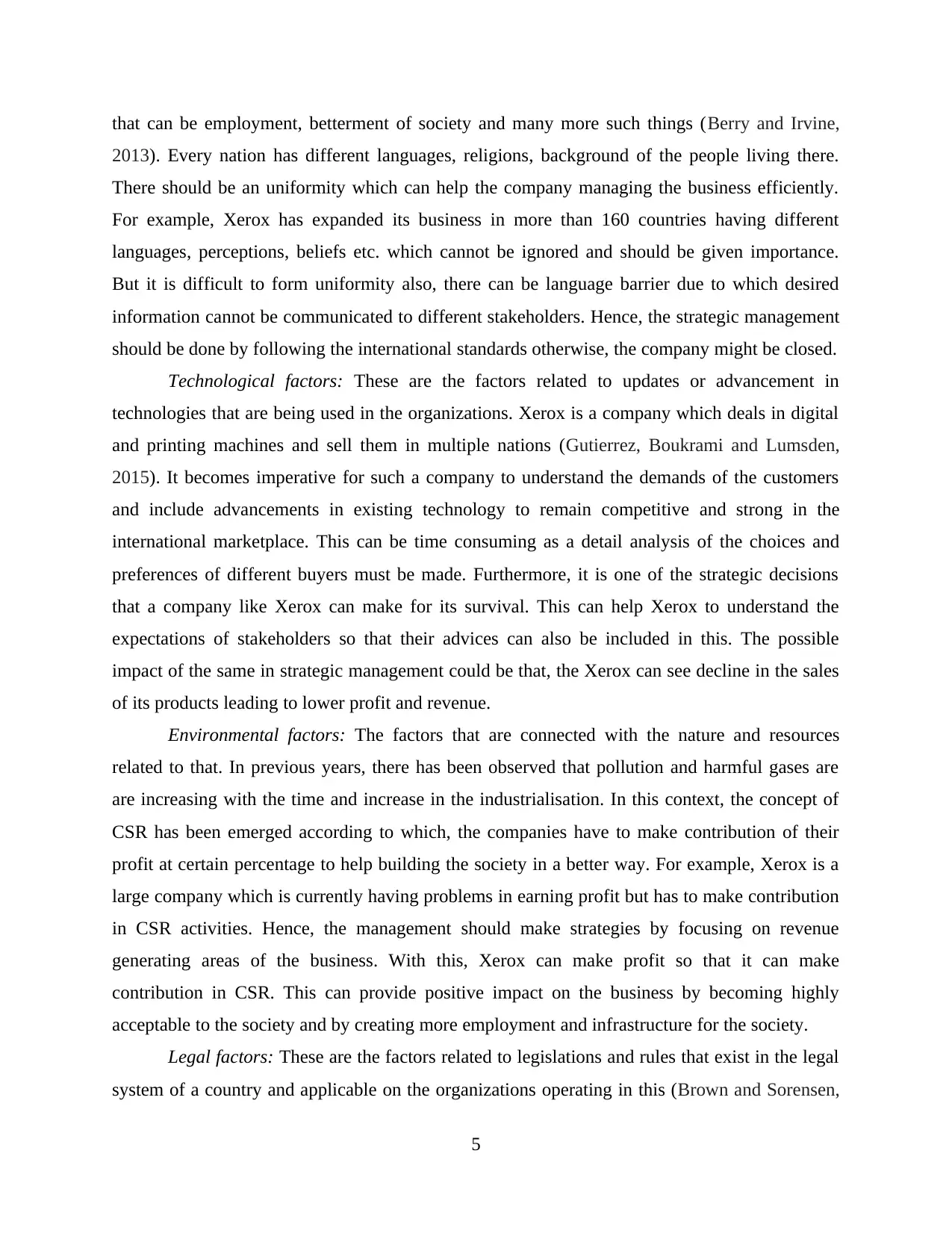
that can be employment, betterment of society and many more such things (Berry and Irvine,
2013). Every nation has different languages, religions, background of the people living there.
There should be an uniformity which can help the company managing the business efficiently.
For example, Xerox has expanded its business in more than 160 countries having different
languages, perceptions, beliefs etc. which cannot be ignored and should be given importance.
But it is difficult to form uniformity also, there can be language barrier due to which desired
information cannot be communicated to different stakeholders. Hence, the strategic management
should be done by following the international standards otherwise, the company might be closed.
Technological factors: These are the factors related to updates or advancement in
technologies that are being used in the organizations. Xerox is a company which deals in digital
and printing machines and sell them in multiple nations (Gutierrez, Boukrami and Lumsden,
2015). It becomes imperative for such a company to understand the demands of the customers
and include advancements in existing technology to remain competitive and strong in the
international marketplace. This can be time consuming as a detail analysis of the choices and
preferences of different buyers must be made. Furthermore, it is one of the strategic decisions
that a company like Xerox can make for its survival. This can help Xerox to understand the
expectations of stakeholders so that their advices can also be included in this. The possible
impact of the same in strategic management could be that, the Xerox can see decline in the sales
of its products leading to lower profit and revenue.
Environmental factors: The factors that are connected with the nature and resources
related to that. In previous years, there has been observed that pollution and harmful gases are
are increasing with the time and increase in the industrialisation. In this context, the concept of
CSR has been emerged according to which, the companies have to make contribution of their
profit at certain percentage to help building the society in a better way. For example, Xerox is a
large company which is currently having problems in earning profit but has to make contribution
in CSR activities. Hence, the management should make strategies by focusing on revenue
generating areas of the business. With this, Xerox can make profit so that it can make
contribution in CSR. This can provide positive impact on the business by becoming highly
acceptable to the society and by creating more employment and infrastructure for the society.
Legal factors: These are the factors related to legislations and rules that exist in the legal
system of a country and applicable on the organizations operating in this (Brown and Sorensen,
5
2013). Every nation has different languages, religions, background of the people living there.
There should be an uniformity which can help the company managing the business efficiently.
For example, Xerox has expanded its business in more than 160 countries having different
languages, perceptions, beliefs etc. which cannot be ignored and should be given importance.
But it is difficult to form uniformity also, there can be language barrier due to which desired
information cannot be communicated to different stakeholders. Hence, the strategic management
should be done by following the international standards otherwise, the company might be closed.
Technological factors: These are the factors related to updates or advancement in
technologies that are being used in the organizations. Xerox is a company which deals in digital
and printing machines and sell them in multiple nations (Gutierrez, Boukrami and Lumsden,
2015). It becomes imperative for such a company to understand the demands of the customers
and include advancements in existing technology to remain competitive and strong in the
international marketplace. This can be time consuming as a detail analysis of the choices and
preferences of different buyers must be made. Furthermore, it is one of the strategic decisions
that a company like Xerox can make for its survival. This can help Xerox to understand the
expectations of stakeholders so that their advices can also be included in this. The possible
impact of the same in strategic management could be that, the Xerox can see decline in the sales
of its products leading to lower profit and revenue.
Environmental factors: The factors that are connected with the nature and resources
related to that. In previous years, there has been observed that pollution and harmful gases are
are increasing with the time and increase in the industrialisation. In this context, the concept of
CSR has been emerged according to which, the companies have to make contribution of their
profit at certain percentage to help building the society in a better way. For example, Xerox is a
large company which is currently having problems in earning profit but has to make contribution
in CSR activities. Hence, the management should make strategies by focusing on revenue
generating areas of the business. With this, Xerox can make profit so that it can make
contribution in CSR. This can provide positive impact on the business by becoming highly
acceptable to the society and by creating more employment and infrastructure for the society.
Legal factors: These are the factors related to legislations and rules that exist in the legal
system of a country and applicable on the organizations operating in this (Brown and Sorensen,
5
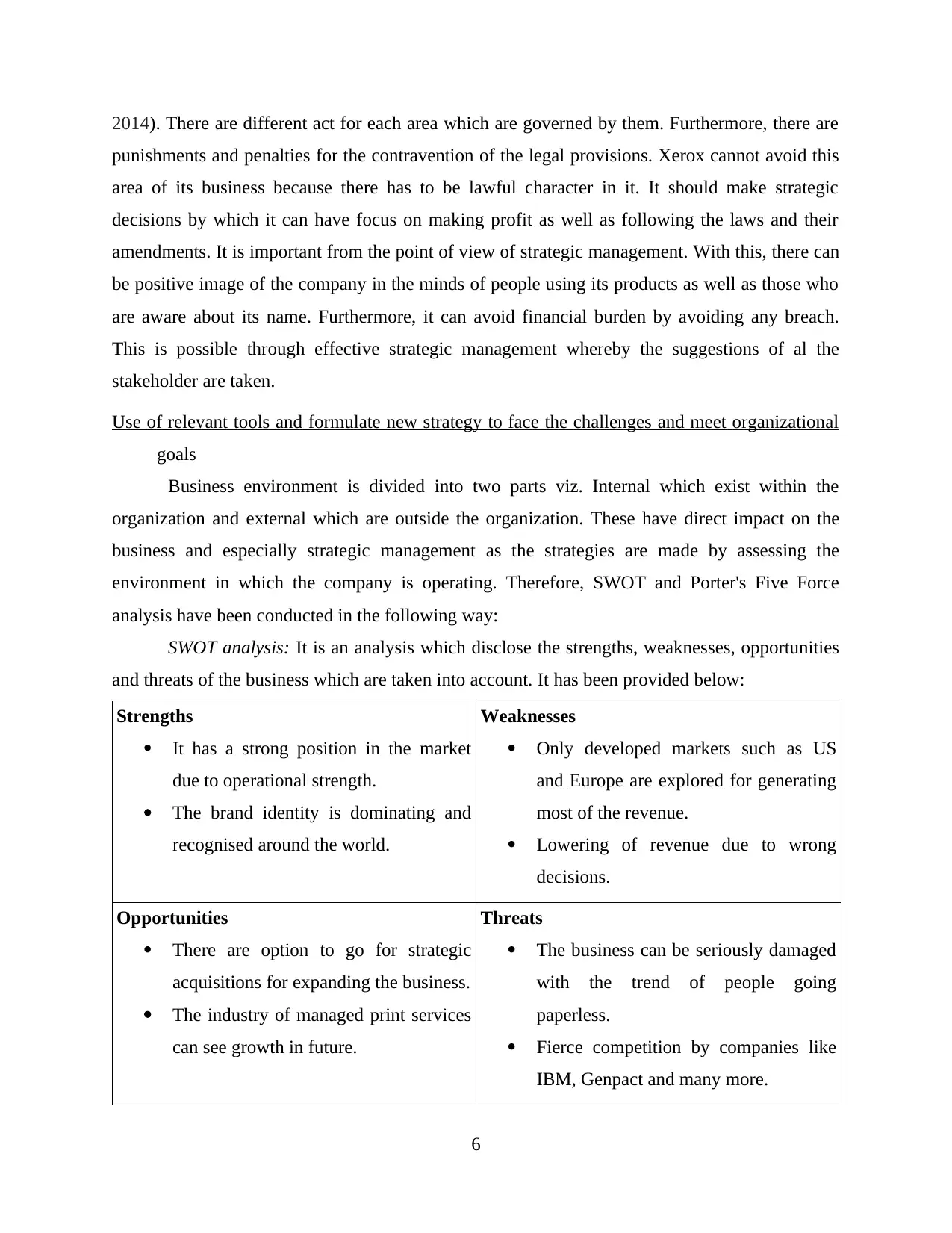
2014). There are different act for each area which are governed by them. Furthermore, there are
punishments and penalties for the contravention of the legal provisions. Xerox cannot avoid this
area of its business because there has to be lawful character in it. It should make strategic
decisions by which it can have focus on making profit as well as following the laws and their
amendments. It is important from the point of view of strategic management. With this, there can
be positive image of the company in the minds of people using its products as well as those who
are aware about its name. Furthermore, it can avoid financial burden by avoiding any breach.
This is possible through effective strategic management whereby the suggestions of al the
stakeholder are taken.
Use of relevant tools and formulate new strategy to face the challenges and meet organizational
goals
Business environment is divided into two parts viz. Internal which exist within the
organization and external which are outside the organization. These have direct impact on the
business and especially strategic management as the strategies are made by assessing the
environment in which the company is operating. Therefore, SWOT and Porter's Five Force
analysis have been conducted in the following way:
SWOT analysis: It is an analysis which disclose the strengths, weaknesses, opportunities
and threats of the business which are taken into account. It has been provided below:
Strengths
It has a strong position in the market
due to operational strength.
The brand identity is dominating and
recognised around the world.
Weaknesses
Only developed markets such as US
and Europe are explored for generating
most of the revenue.
Lowering of revenue due to wrong
decisions.
Opportunities
There are option to go for strategic
acquisitions for expanding the business.
The industry of managed print services
can see growth in future.
Threats
The business can be seriously damaged
with the trend of people going
paperless.
Fierce competition by companies like
IBM, Genpact and many more.
6
punishments and penalties for the contravention of the legal provisions. Xerox cannot avoid this
area of its business because there has to be lawful character in it. It should make strategic
decisions by which it can have focus on making profit as well as following the laws and their
amendments. It is important from the point of view of strategic management. With this, there can
be positive image of the company in the minds of people using its products as well as those who
are aware about its name. Furthermore, it can avoid financial burden by avoiding any breach.
This is possible through effective strategic management whereby the suggestions of al the
stakeholder are taken.
Use of relevant tools and formulate new strategy to face the challenges and meet organizational
goals
Business environment is divided into two parts viz. Internal which exist within the
organization and external which are outside the organization. These have direct impact on the
business and especially strategic management as the strategies are made by assessing the
environment in which the company is operating. Therefore, SWOT and Porter's Five Force
analysis have been conducted in the following way:
SWOT analysis: It is an analysis which disclose the strengths, weaknesses, opportunities
and threats of the business which are taken into account. It has been provided below:
Strengths
It has a strong position in the market
due to operational strength.
The brand identity is dominating and
recognised around the world.
Weaknesses
Only developed markets such as US
and Europe are explored for generating
most of the revenue.
Lowering of revenue due to wrong
decisions.
Opportunities
There are option to go for strategic
acquisitions for expanding the business.
The industry of managed print services
can see growth in future.
Threats
The business can be seriously damaged
with the trend of people going
paperless.
Fierce competition by companies like
IBM, Genpact and many more.
6
⊘ This is a preview!⊘
Do you want full access?
Subscribe today to unlock all pages.

Trusted by 1+ million students worldwide
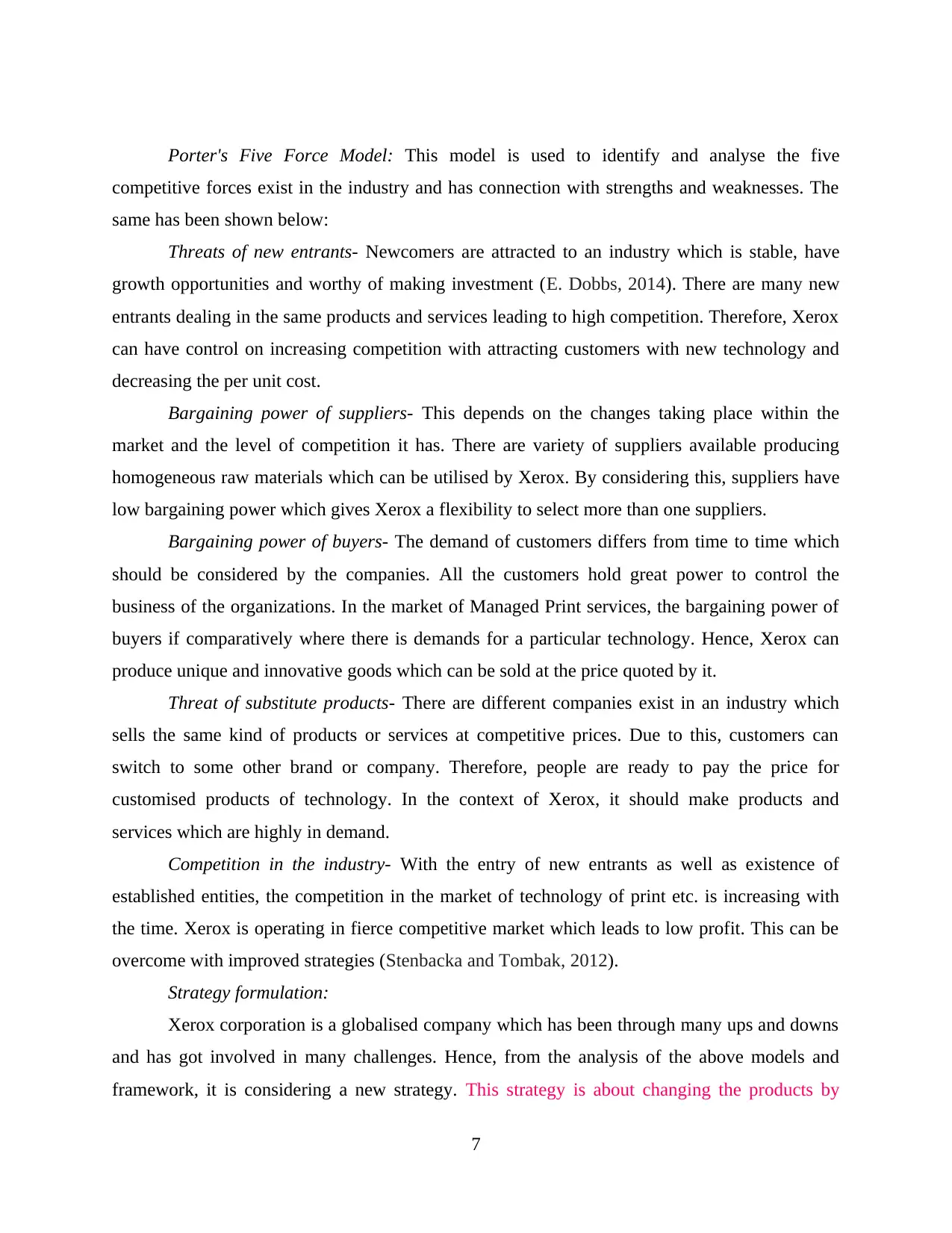
Porter's Five Force Model: This model is used to identify and analyse the five
competitive forces exist in the industry and has connection with strengths and weaknesses. The
same has been shown below:
Threats of new entrants- Newcomers are attracted to an industry which is stable, have
growth opportunities and worthy of making investment (E. Dobbs, 2014). There are many new
entrants dealing in the same products and services leading to high competition. Therefore, Xerox
can have control on increasing competition with attracting customers with new technology and
decreasing the per unit cost.
Bargaining power of suppliers- This depends on the changes taking place within the
market and the level of competition it has. There are variety of suppliers available producing
homogeneous raw materials which can be utilised by Xerox. By considering this, suppliers have
low bargaining power which gives Xerox a flexibility to select more than one suppliers.
Bargaining power of buyers- The demand of customers differs from time to time which
should be considered by the companies. All the customers hold great power to control the
business of the organizations. In the market of Managed Print services, the bargaining power of
buyers if comparatively where there is demands for a particular technology. Hence, Xerox can
produce unique and innovative goods which can be sold at the price quoted by it.
Threat of substitute products- There are different companies exist in an industry which
sells the same kind of products or services at competitive prices. Due to this, customers can
switch to some other brand or company. Therefore, people are ready to pay the price for
customised products of technology. In the context of Xerox, it should make products and
services which are highly in demand.
Competition in the industry- With the entry of new entrants as well as existence of
established entities, the competition in the market of technology of print etc. is increasing with
the time. Xerox is operating in fierce competitive market which leads to low profit. This can be
overcome with improved strategies (Stenbacka and Tombak, 2012).
Strategy formulation:
Xerox corporation is a globalised company which has been through many ups and downs
and has got involved in many challenges. Hence, from the analysis of the above models and
framework, it is considering a new strategy. This strategy is about changing the products by
7
competitive forces exist in the industry and has connection with strengths and weaknesses. The
same has been shown below:
Threats of new entrants- Newcomers are attracted to an industry which is stable, have
growth opportunities and worthy of making investment (E. Dobbs, 2014). There are many new
entrants dealing in the same products and services leading to high competition. Therefore, Xerox
can have control on increasing competition with attracting customers with new technology and
decreasing the per unit cost.
Bargaining power of suppliers- This depends on the changes taking place within the
market and the level of competition it has. There are variety of suppliers available producing
homogeneous raw materials which can be utilised by Xerox. By considering this, suppliers have
low bargaining power which gives Xerox a flexibility to select more than one suppliers.
Bargaining power of buyers- The demand of customers differs from time to time which
should be considered by the companies. All the customers hold great power to control the
business of the organizations. In the market of Managed Print services, the bargaining power of
buyers if comparatively where there is demands for a particular technology. Hence, Xerox can
produce unique and innovative goods which can be sold at the price quoted by it.
Threat of substitute products- There are different companies exist in an industry which
sells the same kind of products or services at competitive prices. Due to this, customers can
switch to some other brand or company. Therefore, people are ready to pay the price for
customised products of technology. In the context of Xerox, it should make products and
services which are highly in demand.
Competition in the industry- With the entry of new entrants as well as existence of
established entities, the competition in the market of technology of print etc. is increasing with
the time. Xerox is operating in fierce competitive market which leads to low profit. This can be
overcome with improved strategies (Stenbacka and Tombak, 2012).
Strategy formulation:
Xerox corporation is a globalised company which has been through many ups and downs
and has got involved in many challenges. Hence, from the analysis of the above models and
framework, it is considering a new strategy. This strategy is about changing the products by
7
Paraphrase This Document
Need a fresh take? Get an instant paraphrase of this document with our AI Paraphraser
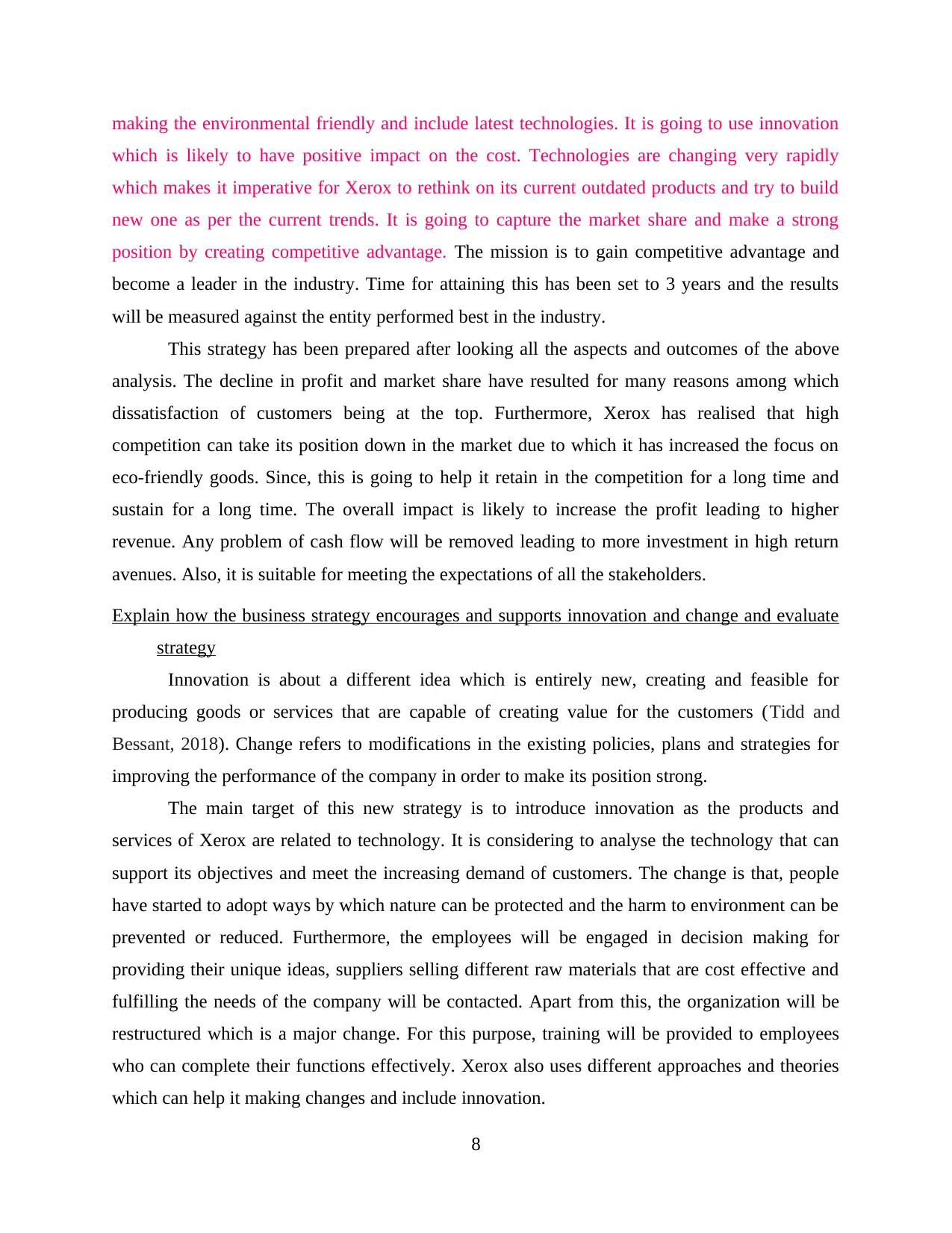
making the environmental friendly and include latest technologies. It is going to use innovation
which is likely to have positive impact on the cost. Technologies are changing very rapidly
which makes it imperative for Xerox to rethink on its current outdated products and try to build
new one as per the current trends. It is going to capture the market share and make a strong
position by creating competitive advantage. The mission is to gain competitive advantage and
become a leader in the industry. Time for attaining this has been set to 3 years and the results
will be measured against the entity performed best in the industry.
This strategy has been prepared after looking all the aspects and outcomes of the above
analysis. The decline in profit and market share have resulted for many reasons among which
dissatisfaction of customers being at the top. Furthermore, Xerox has realised that high
competition can take its position down in the market due to which it has increased the focus on
eco-friendly goods. Since, this is going to help it retain in the competition for a long time and
sustain for a long time. The overall impact is likely to increase the profit leading to higher
revenue. Any problem of cash flow will be removed leading to more investment in high return
avenues. Also, it is suitable for meeting the expectations of all the stakeholders.
Explain how the business strategy encourages and supports innovation and change and evaluate
strategy
Innovation is about a different idea which is entirely new, creating and feasible for
producing goods or services that are capable of creating value for the customers (Tidd and
Bessant, 2018). Change refers to modifications in the existing policies, plans and strategies for
improving the performance of the company in order to make its position strong.
The main target of this new strategy is to introduce innovation as the products and
services of Xerox are related to technology. It is considering to analyse the technology that can
support its objectives and meet the increasing demand of customers. The change is that, people
have started to adopt ways by which nature can be protected and the harm to environment can be
prevented or reduced. Furthermore, the employees will be engaged in decision making for
providing their unique ideas, suppliers selling different raw materials that are cost effective and
fulfilling the needs of the company will be contacted. Apart from this, the organization will be
restructured which is a major change. For this purpose, training will be provided to employees
who can complete their functions effectively. Xerox also uses different approaches and theories
which can help it making changes and include innovation.
8
which is likely to have positive impact on the cost. Technologies are changing very rapidly
which makes it imperative for Xerox to rethink on its current outdated products and try to build
new one as per the current trends. It is going to capture the market share and make a strong
position by creating competitive advantage. The mission is to gain competitive advantage and
become a leader in the industry. Time for attaining this has been set to 3 years and the results
will be measured against the entity performed best in the industry.
This strategy has been prepared after looking all the aspects and outcomes of the above
analysis. The decline in profit and market share have resulted for many reasons among which
dissatisfaction of customers being at the top. Furthermore, Xerox has realised that high
competition can take its position down in the market due to which it has increased the focus on
eco-friendly goods. Since, this is going to help it retain in the competition for a long time and
sustain for a long time. The overall impact is likely to increase the profit leading to higher
revenue. Any problem of cash flow will be removed leading to more investment in high return
avenues. Also, it is suitable for meeting the expectations of all the stakeholders.
Explain how the business strategy encourages and supports innovation and change and evaluate
strategy
Innovation is about a different idea which is entirely new, creating and feasible for
producing goods or services that are capable of creating value for the customers (Tidd and
Bessant, 2018). Change refers to modifications in the existing policies, plans and strategies for
improving the performance of the company in order to make its position strong.
The main target of this new strategy is to introduce innovation as the products and
services of Xerox are related to technology. It is considering to analyse the technology that can
support its objectives and meet the increasing demand of customers. The change is that, people
have started to adopt ways by which nature can be protected and the harm to environment can be
prevented or reduced. Furthermore, the employees will be engaged in decision making for
providing their unique ideas, suppliers selling different raw materials that are cost effective and
fulfilling the needs of the company will be contacted. Apart from this, the organization will be
restructured which is a major change. For this purpose, training will be provided to employees
who can complete their functions effectively. Xerox also uses different approaches and theories
which can help it making changes and include innovation.
8
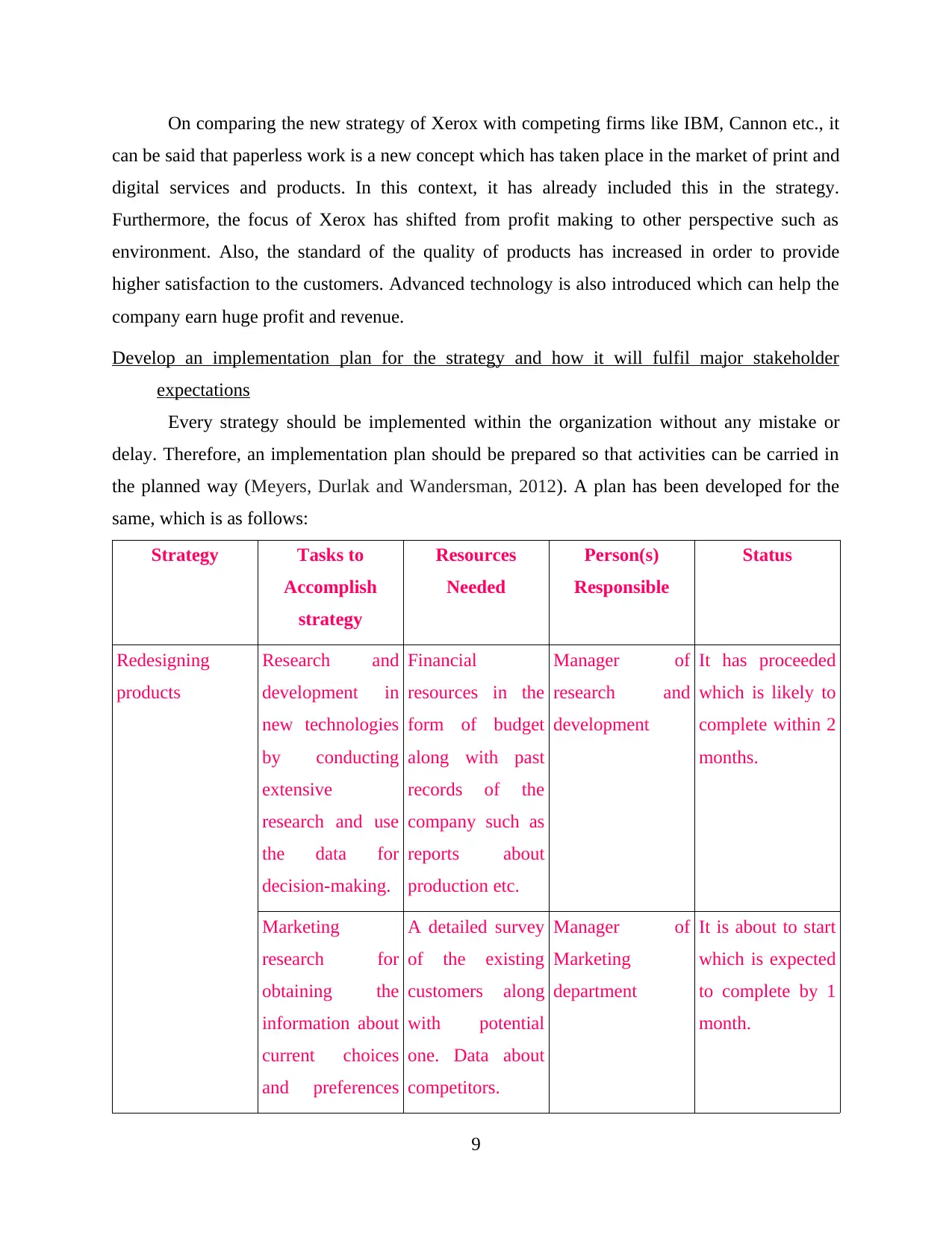
On comparing the new strategy of Xerox with competing firms like IBM, Cannon etc., it
can be said that paperless work is a new concept which has taken place in the market of print and
digital services and products. In this context, it has already included this in the strategy.
Furthermore, the focus of Xerox has shifted from profit making to other perspective such as
environment. Also, the standard of the quality of products has increased in order to provide
higher satisfaction to the customers. Advanced technology is also introduced which can help the
company earn huge profit and revenue.
Develop an implementation plan for the strategy and how it will fulfil major stakeholder
expectations
Every strategy should be implemented within the organization without any mistake or
delay. Therefore, an implementation plan should be prepared so that activities can be carried in
the planned way (Meyers, Durlak and Wandersman, 2012). A plan has been developed for the
same, which is as follows:
Strategy Tasks to
Accomplish
strategy
Resources
Needed
Person(s)
Responsible
Status
Redesigning
products
Research and
development in
new technologies
by conducting
extensive
research and use
the data for
decision-making.
Financial
resources in the
form of budget
along with past
records of the
company such as
reports about
production etc.
Manager of
research and
development
It has proceeded
which is likely to
complete within 2
months.
Marketing
research for
obtaining the
information about
current choices
and preferences
A detailed survey
of the existing
customers along
with potential
one. Data about
competitors.
Manager of
Marketing
department
It is about to start
which is expected
to complete by 1
month.
9
can be said that paperless work is a new concept which has taken place in the market of print and
digital services and products. In this context, it has already included this in the strategy.
Furthermore, the focus of Xerox has shifted from profit making to other perspective such as
environment. Also, the standard of the quality of products has increased in order to provide
higher satisfaction to the customers. Advanced technology is also introduced which can help the
company earn huge profit and revenue.
Develop an implementation plan for the strategy and how it will fulfil major stakeholder
expectations
Every strategy should be implemented within the organization without any mistake or
delay. Therefore, an implementation plan should be prepared so that activities can be carried in
the planned way (Meyers, Durlak and Wandersman, 2012). A plan has been developed for the
same, which is as follows:
Strategy Tasks to
Accomplish
strategy
Resources
Needed
Person(s)
Responsible
Status
Redesigning
products
Research and
development in
new technologies
by conducting
extensive
research and use
the data for
decision-making.
Financial
resources in the
form of budget
along with past
records of the
company such as
reports about
production etc.
Manager of
research and
development
It has proceeded
which is likely to
complete within 2
months.
Marketing
research for
obtaining the
information about
current choices
and preferences
A detailed survey
of the existing
customers along
with potential
one. Data about
competitors.
Manager of
Marketing
department
It is about to start
which is expected
to complete by 1
month.
9
⊘ This is a preview!⊘
Do you want full access?
Subscribe today to unlock all pages.

Trusted by 1+ million students worldwide
1 out of 23
Related Documents
Your All-in-One AI-Powered Toolkit for Academic Success.
+13062052269
info@desklib.com
Available 24*7 on WhatsApp / Email
![[object Object]](/_next/static/media/star-bottom.7253800d.svg)
Unlock your academic potential
Copyright © 2020–2025 A2Z Services. All Rights Reserved. Developed and managed by ZUCOL.




